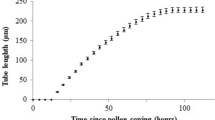Summary
A method was worked out using trifluoromethanesulfonic acid (TFMS) as a reagent to split the covalently bound proteins, which are NaCl insoluble, from pollen tube walls of Lilium longiflorum, leaving the peptide bonds essentially intact. After electrophoretic separation, comparisons were made among these proteins from pollen grains and pollen tubes grown in vitro and in styles after self- and cross-pollination. It was found that a) the patterns of covalently bound wall proteins were different between tubes grown in vitro and in vivo; b) fewer bands were found in covalently bound wall proteins than that in noncovalently bound proteins; c) the bands remained almost the same no matter whether the tubes had been cross pollinated or self pollinated, indicating that while the noncovalently bound proteins were involved in incompatibility as shown in the previous paper, the covalently bound proteins may only serve as a structural component, having little to do with incompatibility.
Similar content being viewed by others
References
Bailey RW, Kauss H (1974) Extraction of hydroxyproline-containing proteins and pectic substances from cell walls of growing and non-growing mung bean hypocotyl segments. Planta 119:233–245
Cooper JB, Varner JE (1983) Insolubilization of hydroxyproline rich cell wall glycoprotein in aerated carrot root slices. Biochem Biophys Res Commun 112:161–167
Coudron C, Ellis K, Philipson L, Schwartz N (1980) Preliminary characterization of a xylose acceptor prepared by hydrogen fluoride treatment of proteoglycan core protein. Biochem Biophys Res Commun 92:618–623
Dickinson DB (1968) Rapid starch synthesis with increased respiration in germinating lily pollen. Plant Physiol 43:1–8
Edge ASB, Faltynek CR, Hof L, Reichret LE, Weber P (1981) Deglycosylation of glycoproteins by trifluoromethanesulfonic acid. Anal Biochem 118:131–137
Fry SC (1982) Isodityrosine, a new cross-linking amino acid from cell wall glycoprotein. Biochem J 204:449–455
Glassman JHS, Todd CN, Shiveley JE (1978) Chemical deglycosylation of carcinoembryonic antigen for amino acid sequence studies. Biochem Biophys Res Commun 85:209–216
Heath MF, Northcote DH (1971) Glycoprotein of the wall of sycamore tissue-culture cells. Biochem J 125:953–961
King NJ, Bayley ST (1966) A preliminary analysis of the proteins of the primary walls of some plant cells. J Exp Bot 16:294–303
Kroh M (1967) Fine structure of Petunia pollen germinated in vivo. Rev Palaeobotan Palynol 3:197–203
Lamport DTA (1965) The protein of primary cell walls. In: Preston RD (ed) Adv bot res vol 2. Academic Press, London New York, pp 151–218
Lamport DTA (1969) The isolation and partial characterization of hydroxyproline rich glycoproteins obtained by enzymic degradation of primary cell walls. Biochemistry 8:1155–1163
Lamport DTA (1980) Structure and function of plant glycoproteins. In: Preiss J (ed) Biochemistry of plants, vol 3. Academic Press, New York, pp 501–541
Lamport DTA, Catt JW (1981) Glycoproteins and enzymes of the cell wall. Encyl Plant Physiol 13B: 130–141
Lamport DTA, Miller DH (1971) Hydroxyproline arabinosides in the plant kingdom. Plant Physiol 48:454–456
Lamport DTA, Epstein L (1983) A new model for the primary cell wall: a concatenated extension-cellulose network. In: Randall DD (eds) Curr top plant biochem physiol symp, vol 2. University of Missouri, Columbia, pp 73–83
Li Yi-qin, Linskens HF (1983a) Wall-bound proteins of pollen tubes after self- and cross-pollination in Lillium longiflorum. Theor Appl Genet 67:11–16
Li Yi-qin, Linskens HF (1983b) Neutral sugar composition of pollen tube walls of Lilium longiflorum. Acta Bot Neerl 32:437–445
Li Yi-qin, Croes AF, Linskens HF (1983) Cell wall proteins in pollen and roots of Lilium logiflorum: extraction and partial characterization. Planta 158:422–427
Linskens HF (1964) Pollen physiology. Annu Rev Plant Physiol 15:255–270
Linskens HF (1969) Fertilization mechanism in higher plants. In: Metz C, Monroy A (eds) Fertilization, vol 2. Academic Press, New York, pp 189–254
Mort AJ, Lamport DTA (1977) Anhydrous hydrogen fluoride deglycosylates glycoproteins. Anal Biochem 82:289–309
Sairam MR, Schiller PW (1979) Receptor binding, biological, and immunological properties of chemically deglycosylated pituitary eutropin. Arch Biochem Biophys 197:294–301
Schrauwen JAM, Linskens HF (1967) Mass culture of pollen tubes. Acta Bot Neerl 16:177–179
Voigt VJ (1984) A study of cross-links between the glycoprotein subunits within the insoluble inner cell wall layer of Chlamydomonas reinhardii. Mitt Inst Allg Bot, Hamburg 19:83–98
Author information
Authors and Affiliations
Additional information
Communicated by H.F.Linskens
Rights and permissions
About this article
Cite this article
Yi-qin, L., Tsao, T.H. Covalently bound wall proteins of pollen grains and pollen tubes grown in vitro and in styles after self- and cross-pollination in Lilium longiflorum . Theoret. Appl. Genetics 71, 263–267 (1985). https://doi.org/10.1007/BF00252065
Received:
Accepted:
Issue Date:
DOI: https://doi.org/10.1007/BF00252065




